Michigan’s food scene is a delicious blend of cultural influences, fresh ingredients, and regional pride. From Detroit’s urban specialties to Upper Peninsula traditions, the Great Lakes State offers unforgettable culinary experiences. Whether you’re a lifelong resident or first-time visitor, these 15 iconic Michigan eats deserve a spot on your must-try list.
1. Detroit-Style Pizza: The Crispy-Edged Wonder

Motor City magic happens when cheese caramelizes against the edges of a square steel pan. Unlike its round cousins, Detroit-style pizza flips tradition upside down with its distinctive layering—cheese first, toppings second, sauce last. The crust deserves special attention—airy on the inside yet wonderfully crunchy where it meets the pan. Many Michiganders judge a proper Detroit-style pizza by the sound it makes when you bite into that perfectly crisp edge. Local pizzerias debate whose recipe reigns supreme, but they all share the same foundational elements: Wisconsin brick cheese, twice-baked dough, and that signature red sauce racing stripe on top.
2. Coney Dog: A Hot Debate Between Cities

Ask any Michigander about Coney dogs and you’ll spark a friendly rivalry between Detroit and Flint styles. The foundation remains the same—a natural-casing hot dog nestled in a steamed bun—but the chili topping tells the tale of two cities. Detroit’s version features a wet, beanless beef heart chili that’s more sauce-like, while Flint proudly serves a drier, meatier topping. Both come crowned with yellow mustard and diced raw onions for that perfect flavor balance. The most famous purveyors sit literally next door to each other in downtown Detroit: American and Lafayette Coney Islands, where locals fiercely defend their favorite in a debate that’s raged since 1917.
3. Pasty: The Miner’s Lunch Pail Staple
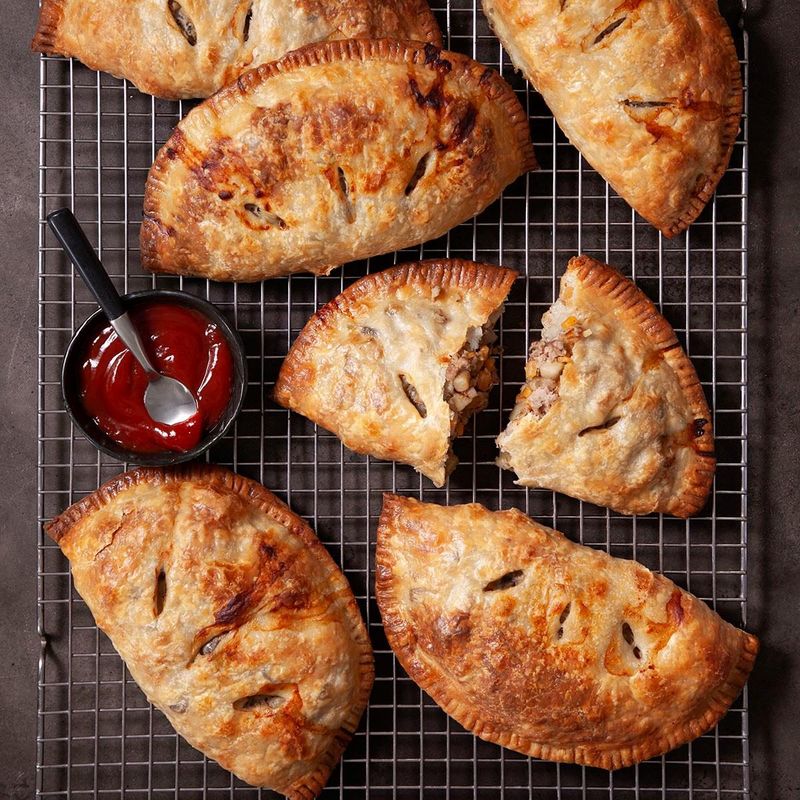
Cornish miners brought these hearty hand pies to Michigan’s Upper Peninsula in the 1800s, creating a portable meal that could withstand hours in the depths of copper and iron mines. The traditional recipe—beef, potatoes, rutabaga, and onions wrapped in flaky pastry—remains largely unchanged today. U.P. residents debate the proper condiment: ketchup or gravy? Some purists insist they should be eaten plain, just as the miners did. Each town claims to have the best pasty shop, with recipes guarded like family treasures. Modern variations might include chicken or vegetarian fillings, but the classic beef pasty endures as the Upper Peninsula’s most iconic contribution to Michigan’s food identity.
4. Mackinac Island Fudge: Sweet Tourism Tradition
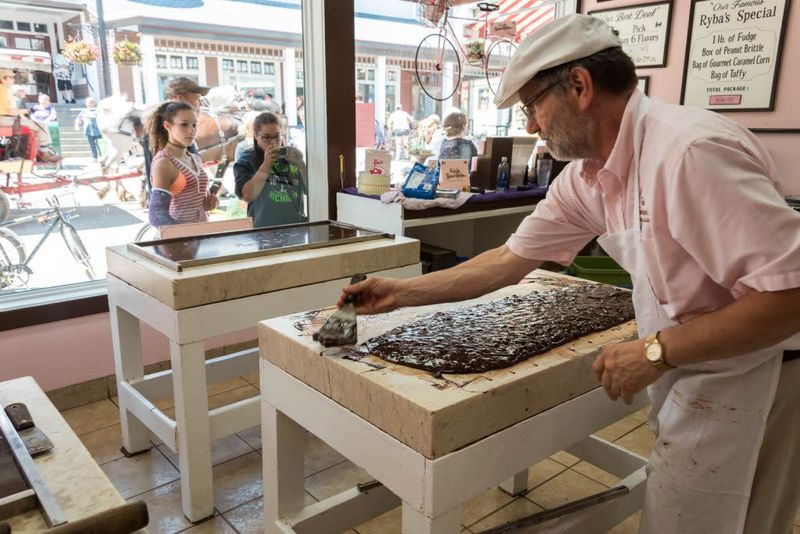
The rhythmic paddle-scraping of fudge-makers on marble slabs has become the soundtrack of Mackinac Island summers. Visitors crowd around shop windows to witness the hypnotic process before sampling creamy chocolate confections that have defined the island’s identity for over a century. Original Murdick’s Fudge opened in 1887, pioneering a tourism tradition that’s earned Mackinac its nickname: America’s Fudge Capital. Today, over a dozen fudge shops produce 10,000+ pounds during peak season weeks. While chocolate remains the foundation, innovative flavors like maple butter pecan and Michigan cherry have expanded the palette. True Mackinac veterans know the best time to buy is late afternoon when fresh batches emerge warm from the cooling tables.
5. Better Made Potato Chips: Detroit’s Crunchy Legacy
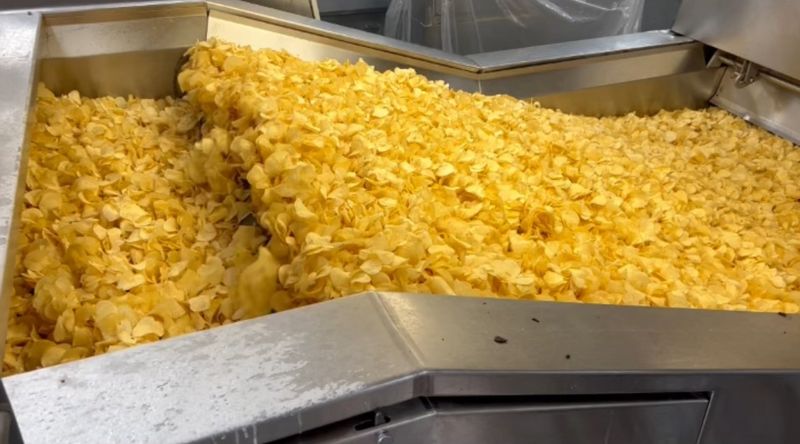
Born in the Motor City during the Great Depression, these distinctive yellow bags have delivered consistent crunch for over 90 years. Cross & Peters started with a single fryer in 1930, selecting only Michigan potatoes for their perfect starch content and flavor. The original recipe remains unchanged—potatoes, oil, salt—though the rainbow of flavors has expanded dramatically. Detroiters swear by the Special Dark variety, featuring chips cooked slightly longer for extra crispness and deeper flavor. Factory tours in Detroit have become a local school field trip tradition, where children watch potatoes transform from humble spuds to golden crisps. The company’s commitment to Michigan agriculture makes these chips a truly homegrown snack experience.
6. Traverse City Cherry Pie: Ruby Red Perfection

Northern Michigan’s cherry orchards burst with tart Montmorency fruit each July, transforming Traverse City into the Cherry Capital of the World. These ruby gems create pies with the perfect sweet-tart balance that can’t be replicated with any other cherry variety. Local bakers guard their crust recipes with fierce pride. Some swear by lard for flakiness, others by butter for flavor, but all agree that the filling should showcase the natural brightness of Michigan cherries without excessive sugar. The National Cherry Festival celebrates this iconic dessert annually, hosting pie-eating contests and baking competitions. For the authentic experience, cherry pie must be served warm with a scoop of vanilla ice cream slowly melting into the filling.
7. Superman Ice Cream: Childhood in a Scoop

The origin of this tricolor treat remains mysteriously Michigan-centric, with Stroh’s Brewery (which once made ice cream during Prohibition) often credited as its creator. Blue moon, red pop, and lemon flavors swirl together in a patriotic combination that’s become a staple at Michigan ice cream parlors. Children gleefully request it by name, often ending up with rainbow-stained tongues and fingers. The exact flavors vary between creameries—some use black cherry instead of red pop, others blueberry instead of blue moon—but the vibrant color combination remains consistent. Despite attempts to explain its name connection to the comic book hero, the ice cream actually predates Superman’s first appearance. Whatever its origins, this colorful creation remains a uniquely Michigan way to cool down on hot summer days.
8. Wet Burrito: Grand Rapids’ Saucy Creation

Grand Rapids restaurants transformed the humble burrito by drowning it in savory red enchilada sauce and melted cheese. Unlike its handheld cousin, this knife-and-fork affair creates a deliciously messy experience that’s become a West Michigan specialty. The filling typically features seasoned ground beef or chicken with refried beans, but it’s the sauce that distinguishes a proper wet burrito. Traditional recipes call for a mild-to-medium heat level that complements rather than overwhelms the other flavors. Many Grand Rapids families maintain fierce loyalty to neighborhood Mexican restaurants, passing their burrito preferences through generations. While chain restaurants have attempted to replicate this regional specialty, locals insist only West Michigan establishments capture the authentic combination of flavors and textures.
9. Great Lakes Whitefish: Fresh-Caught Delicacy

Commercial fishing boats still bring this delicate catch to Michigan’s shoreline communities, where restaurants serve it within hours of harvest. The mild, flaky flesh provides the perfect canvas for both traditional and innovative preparations. Smoked whitefish represents perhaps the most iconic preparation, especially in the Upper Peninsula. The gentle smoking process preserves the fish’s natural sweetness while adding complexity. Whitefish dip—smoked fish blended with cream cheese and seasonings—appears at nearly every Michigan gathering. Sustainability concerns have led to careful management of whitefish populations in the Great Lakes. Many restaurants proudly identify which lake provided their daily catch, with Lake Superior and Lake Michigan varieties each claiming distinctive flavor profiles based on water temperature and diet.
10. Olive Burger: Lansing’s Savory Signature

Only in Michigan would chopped green olives mixed with mayonnaise become a beloved burger topping. This curious combination originated in Lansing, where the Kewpee Hotel Hamburgs claimed to create it in the 1920s, though several restaurants now compete for the title of originator. The olive mayo provides a briny, savory punch that cuts through the richness of the beef patty. Most traditional preparations keep it simple—just the olive spread, sometimes with lettuce and a slice of melted cheese on a steamed bun. Michigan transplants often report craving this hometown specialty when they move away. The olive burger represents Michigan’s knack for creating distinctive regional variations on American classics, turning a simple addition into a state-defining culinary tradition.
11. Apple Cider & Donuts: Autumn’s Perfect Pairing
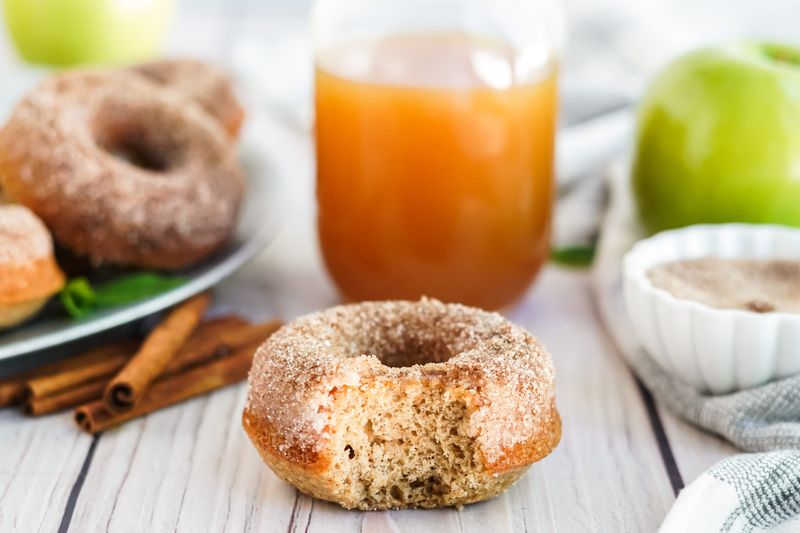
When September arrives, Michiganders instinctively head to their favorite orchards for this seasonal ritual. The cider—pressed from a blend of local apple varieties—delivers complex flavors that bottled versions can never match, especially when served warm with a cinnamon stick. The donuts emerge piping hot from fryers before being tossed in cinnamon-sugar. Their cake-like texture offers the perfect contrast to the tangy cider. Many orchards still use decades-old recipes and equipment, creating consistency that spans generations. Beyond mere sustenance, this pairing has become a cherished social tradition. Families gather at picnic tables amid colorful foliage, hayrides rumble past, and for a moment, the simple pleasure of fresh donuts and cider creates the quintessential Michigan fall experience.
12. Pączki: Fat Tuesday’s Polish Indulgence

Hamtramck bakeries start production days before Fat Tuesday to meet the staggering demand for these rich Polish pastries. Unlike ordinary donuts, pączki (pronounced “poonch-key”) feature enriched dough with extra eggs, butter, and sometimes alcohol, creating a distinctive texture and flavor profile. Traditional fillings include prune, rosehip, and custard, though American adaptations now include everything from chocolate to strawberry. The dense, yeasty treats get a final dusting of powdered sugar or glaze before eager customers line up—often before dawn—to secure their dozen. Michigan’s celebration of this pre-Lenten indulgence reflects the state’s strong Polish heritage, especially in Detroit and Hamtramck. Many workplaces across Michigan now host pączki days, spreading this cultural tradition beyond its ethnic origins.
13. Trenary Toast: Upper Peninsula’s Crunchy Souvenir
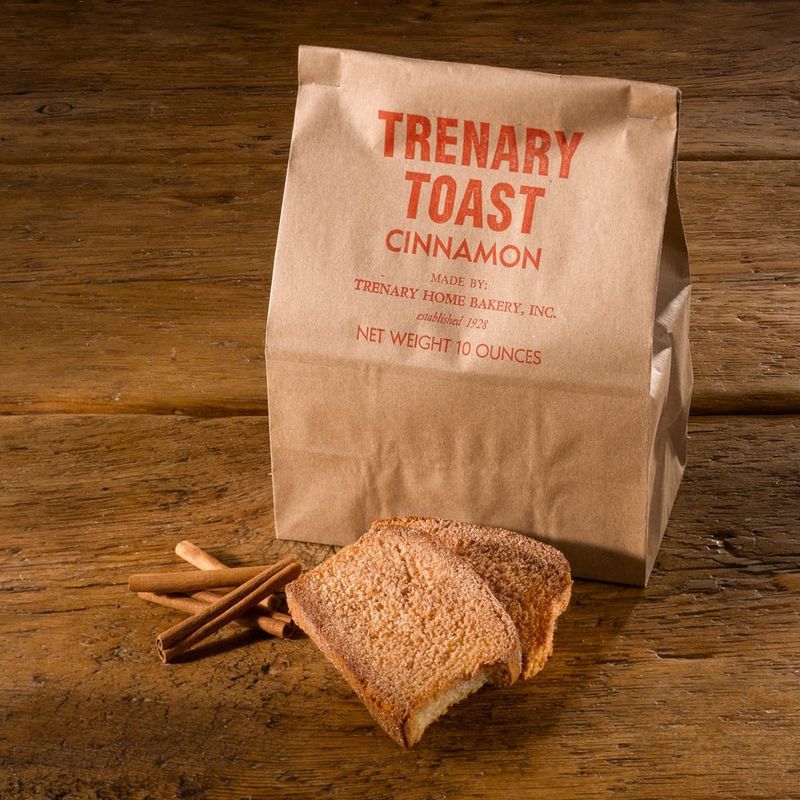
Finnish immigrants brought the concept of twice-baked bread to Michigan’s Upper Peninsula, where the small town of Trenary transformed it into a regional icon. These rock-hard cinnamon toast slices might break teeth if not properly prepared—locals know to dunk them in coffee until they reach the perfect softened consistency. The Trenary Home Bakery has produced these simple treats since 1928, maintaining the original recipe of bread, sugar, and cinnamon. Their impressive shelf life made them practical for long U.P. winters before modern food preservation. Visitors to the Upper Peninsula often bring home bags as souvenirs. The plain brown packaging and hand-stamped logo remain charmingly unchanged, representing the U.P.’s unpretentious approach to culinary traditions.
14. Cudighi Sandwich: The U.P.’s Italian Influence

Italian miners brought this spiced sausage recipe to Upper Peninsula towns like Ishpeming and Marquette, where it evolved into a distinctive sandwich beloved throughout the region. The sausage itself contains a unique blend of spices—cinnamon, nutmeg, and cloves mix with traditional Italian seasonings for a flavor profile found nowhere else. A proper cudighi sandwich comes on a long roll with mozzarella cheese and tomato sauce. Some U.P. establishments add grilled onions and peppers, creating a hybrid between Italian sausage sandwich and American sub. Despite gaining occasional national attention, cudighi remains primarily a hyperlocal specialty. Many U.P. families still make homemade versions using recipes passed through generations, preserving this delicious example of immigrant influence on Michigan’s culinary landscape.
15. Vernors Ginger Ale: Michigan’s Medicinal Soda
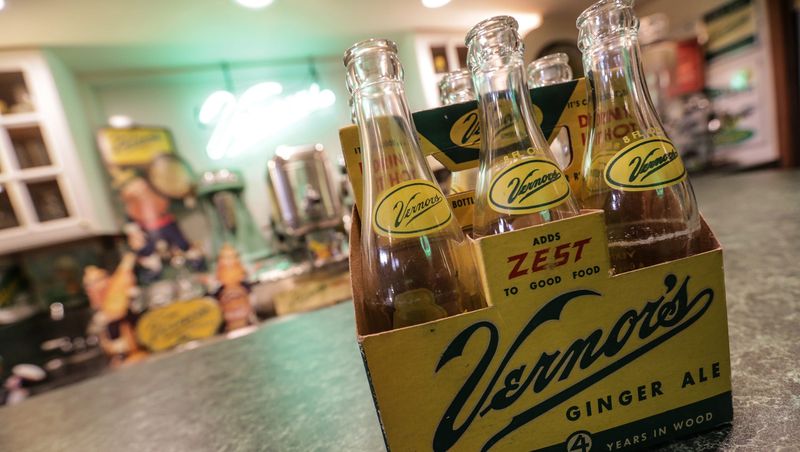
America’s oldest surviving ginger ale wasn’t just created for refreshment—pharmacist James Vernor developed it in Detroit before the Civil War as a stomach remedy. The secret recipe reportedly aged in wooden barrels during his military service, creating the distinctive vanilla notes that complement its ginger bite. Michigan mothers have long prescribed “Vernors and saltines” for upset stomachs. The distinctive golden soda maintains a fiercely loyal following, especially for its Boston Cooler variation—a vanilla ice cream float named not for Massachusetts but for Detroit’s Boston Boulevard. The ginger flavor hits stronger than national brands, with a robust carbonation locals describe as “tickling your nose.” Though now owned by a larger corporation, Vernors remains a taste of home for Michiganders, especially during holidays when it features in family recipes.


